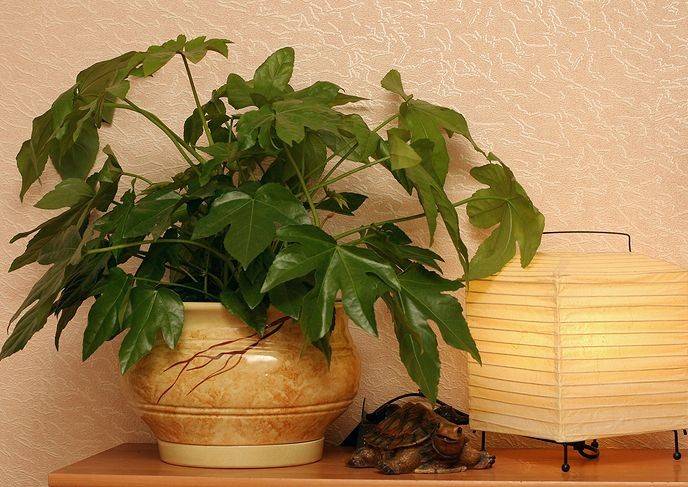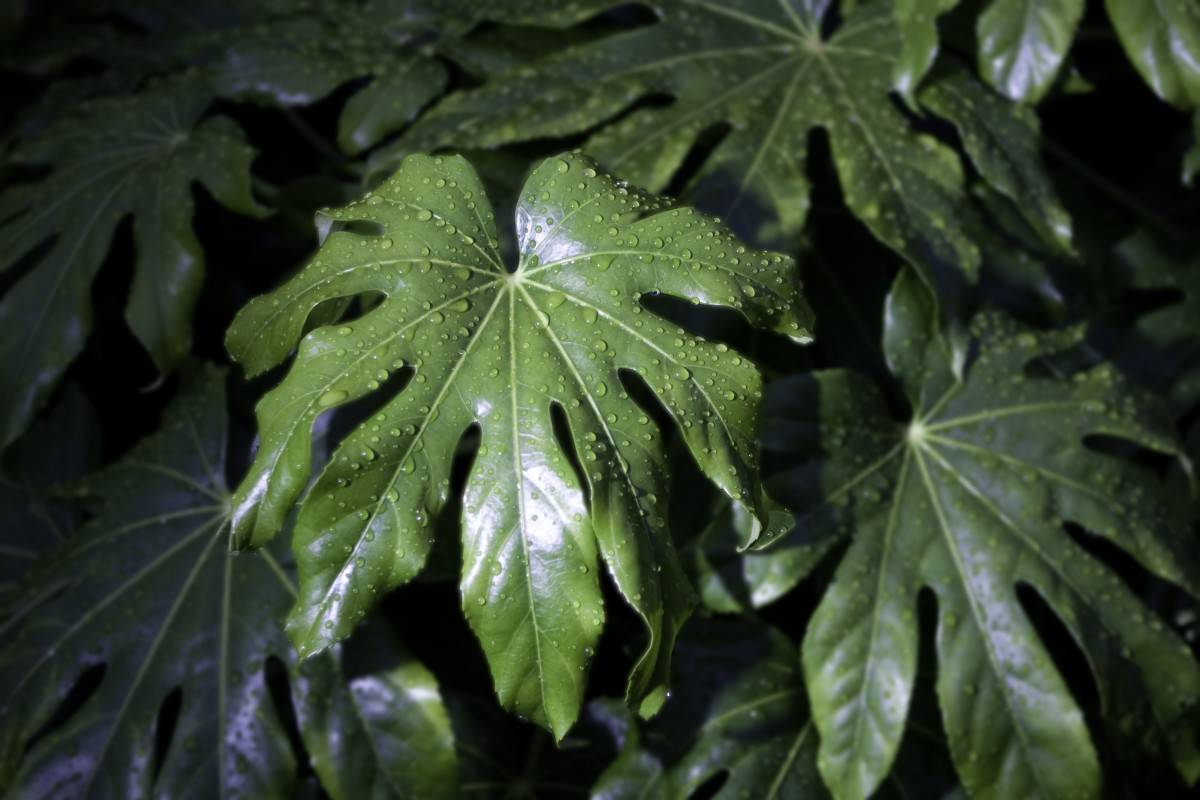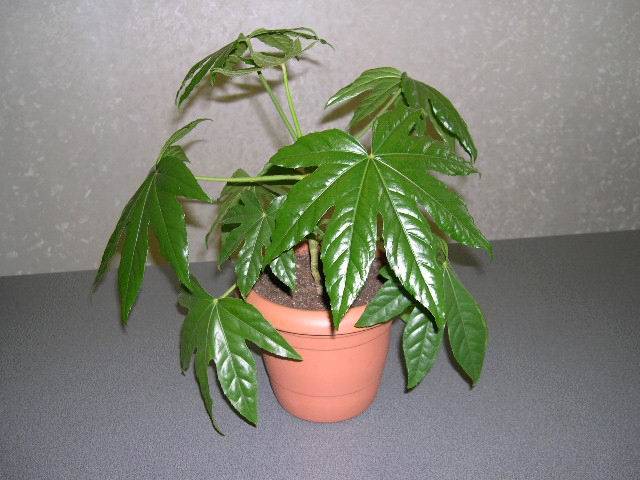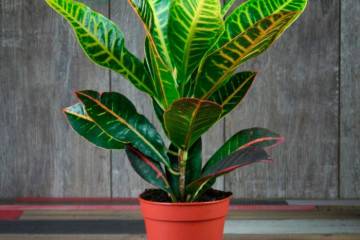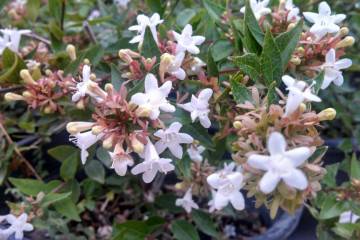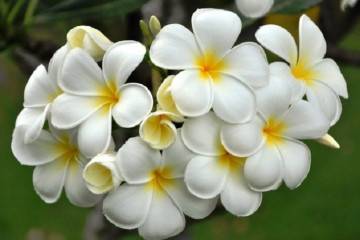Fatsia flower: home care and breeding methods
Content:
Fatsia is an ornamental plant designed to be kept in large rooms. Bushes grow rapidly. With good care, they can reach a height of 2 meters. Fatsia care at home is simple. The following is information about cultivation, methods of reproduction, and the toxicity of the flower.
Main types
The culture belongs to the Araliev family, the Fatsia clan. The genus is represented by the only species - Japanese Fatsia. There are varieties that have gained the most popularity among flower growers. Fatsia blooms in autumn, when many plants are already preparing for wintering. It is enough to see how cute the fatsia blooms once to fall in love with this plant.
Fatsia Samurai
Bushes grow quickly: after 2 years they are able to reach a height of 1.5 meters. The leaves are green, glossy. They grow up to 35 centimeters in diameter. Longitudinal veins are clearly visible on the leaf plates. Fatsia Samurai will do well in large rooms.
Fatsia Variegatnaya
The bushes are small: they reach no more than 90 centimeters in height. The leaf plates are large, finger-dissected. Irregular cream-colored spots are located all over the surface. Fatsia variegated prefers to grow in a well-lit place, otherwise the leaf plates may lose their decorative effect.
Fatsia: home care
To maintain a decorative appearance, the flower is watered in a timely manner, periodically sprayed with water from a spray bottle. From spring to autumn, the culture is fed twice a month. That's all that Japanese fatsia requires, which is not laborious to care for.
Air humidity
Fatsia (aralia) has large leaves that need hydration. To do this, they are sprayed with water from a spray bottle, wiped with a damp cloth. Periodically, kutam can be given a shower. To prevent water from getting into the pot, cover it with foil.
To humidify the air, small stones are poured into the pallet, filled with water. Then a pot of fatsia is placed in it. In winter, the radiator can be covered with a damp cloth.
Watering
A large plant requires abundant watering. They irrigate the ground after the topsoil dries out. Water is used warm, well-separated. After 30-40 minutes, the excess liquid is poured from the pan. The culture equally badly tolerates both stagnant water and a lack of moisture.
In winter, when kept cool, the bushes are watered sparingly. In this case, you need to ensure that the leaves of the fatsia do not go down. Even after a single omission, the decorativeness of the plant may not be restored.
Temperature
The optimum temperature for keeping fatsia is 18-23 ° C. In summer, it can be taken out onto a balcony, loggia, terrace. The main thing is that she is under cover from direct sunlight. Otherwise, the leaves from the heat may begin to dry.
The culture prefers to overwinter in a cool place. But the air temperature should not drop below 15 ° C. When the flower is kept warm, the room should be well lit. For this, fluorescent lamps are used.
Pruning
Obligatory pruning for indoor fatsia flower is not required. And in order for the bush to grow not only upward, but also in breadth, the top must be pinched.After that, a beautiful crown will form.
Plant transplant
It is better to buy a young plant in a flower shop. It will more easily adapt to new conditions of detention. Then he is quarantined separately for 2 weeks. If signs of damage by diseases or pests are detected, the flower is sprayed with special preparations.
Fatsia needs to be replanted every spring. The culture grows quickly, so after a year the pot becomes small for the root system. At the same time, the new container in diameter should be larger than the previous one by only 2.5-4 centimeters. Plants over 4 years old are transplanted once every 3 years.
The substrate for fatsia is selected light, loose. It is purchased in a specialized store. The culture will grow well in the soil recommended for planting decorative deciduous plants.
Fatsia is transplanted as follows:
- The bottom of the pot is covered with a layer of small stones, expanded clay.
- Pour the prepared substrate.
- Remove the plant from the pot, lightly shake off the old soil.
- Planted in a new pot, watered abundantly.
If, during transplantation, it is found that some parts of the plant have begun to rot, they are cut off. To prevent the spread of the disease, the bushes are sprayed with a fungicide, then the cuts are sprinkled with charcoal.
Reproduction methods
At home, fatsia is easy to dilute with cuttings and layering. Seed propagation by flower growers is rarely used because of its laboriousness.
Cuttings
The breeding procedure is started in the spring, during the period of active growth of the flower. To do this, perform the following steps:
- The apical shoot with 2-3 buds is separated with a sharp, disinfected instrument.
- The section is treated with a growth enhancer.
- A loose, air-permeable and permeable substrate is poured into the pot.
- A stalk is planted, watered.
For quick rooting, the shoot is covered with plastic wrap. You need to make sure that it does not come into contact with the plant. Otherwise, from the moisture formed by condensation drops, the leaves may begin to rot.
Seeds
The seed reproduction procedure is performed as follows:
- The seeds are soaked for 48 hours in room temperature water.
- Loose, fertile soil is poured into the box.
- Seeds are spread over the surface.
- Cover them with a centimeter layer of soil.
- Watering.
The box with seeds is covered with glass or foil, put in a warm place. Every day, the shelter is removed to ventilate the container. Wipe off condensation from the walls of the box and from the covering material.
When 2 full leaves are formed on the seedlings, a pick is made. Plants are planted in separate small pots. As the fatsia grows, the size of the containers increases in size.
Layers
This method is used if the fatsia flower loses its decorative effect, stretches out. To do this, make an incision on the trunk, cover it with wet sphagnum moss. Moss can be moistened not just in water, but in a nutrient mixture. To do this, add a few drops of complex fertilizer to 1 liter of water.
On top of the moss, the trunk is covered with a film, which is tied with a rope. After some time, roots form in this place. Cut off the cut below the rooting site, planted in a pot.
Poisonousness of the flower
All parts of fatsia are used in folk medicine to treat various ailments. It is believed that the presence of this flower in the house creates a favorable atmosphere, fills it with positive energy.
Some growers are afraid to acquire a crop because of the poisonous leaves. But the poisonous juice has a weak concentration. Therefore, only florists prone to allergies need to be afraid. And keep children and animals away from the plant.
Care should be taken when transplanting a flower and pruning shoots. To avoid getting juice on exposed skin, the procedure must be carried out with gloves.
Fatsia Japonica is a beautiful ornamental plant. Its large leaves can become the main decoration of the room. To maintain a decorative look, proper home care for Japanese fatsia is required. It requires watering as the top layer of the soil dries out, fertilization from spring to autumn, and pruning of elongated shoots. All this does not require much effort, but a beautiful and useful plant will be the reward.
